Abstract
The virulence plasmids of Salmonella typhimurium and other invasive Salmonella serovars have long been associated with the ability of these bacteria to cause systemic infection beyond the intestines in orally inoculated animals. Genetic analysis of virulence genes on the high-molecular-weight plasmids has revealed that no more than five genes spanning a 6.2-kb region are sufficient to replace the entire plasmid for conferring virulence. However, the exact virulence function(s) encoded by these genes has not been elucidated. In this report, we measured the possible effect of the virulence plasmid on the growth rate of S. typhimurium in mice by two complementary procedures. The first procedure used segregation of a temperature-sensitive plasmid in vivo to provide a measure of bacterial divisions and the number of recovered marker plasmid-containing salmonellae as a measure of killing. In the second procedure, aroA deletions were transduced into virulence plasmid-containing and plasmid-cured S. typhimurium. Since AroA- salmonellae are inhibited for growth in vivo, if the virulence plasmid affected only growth rate, no difference in the recoveries of the paired AroA- strains would be seen. Virulence plasmid-containing S. typhimurium segregated the marker plasmid more rapidly than did the virulence plasmid-cured strain, and AroA- derivatives of both strains were recovered equally from mice. Therefore, the S. typhimurium virulence plasmid increased growth rate but had no detectable effect on killing or bacterial movement into deep tissues. To examine whether the plasmid accomplished this function by affecting the intracellular/extracellular location of bacteria, orally infected mice were injected with gentamicin to kill the extracellular bacteria. Wild-type and plasmid-cured S. typhimurium strains were equally resistant to gentamicin in vivo and hence most likely located intracellularly to equal degrees. When wild-type and plasmid-cured S. typhimurium strains were sequestered within peritoneal chambers in mice, the resulting extracellular growth was equal. Therefore, the virulence plasmid increases the growth rate of S. typhimurium in mice, probably within mouse cells.
Full text
PDF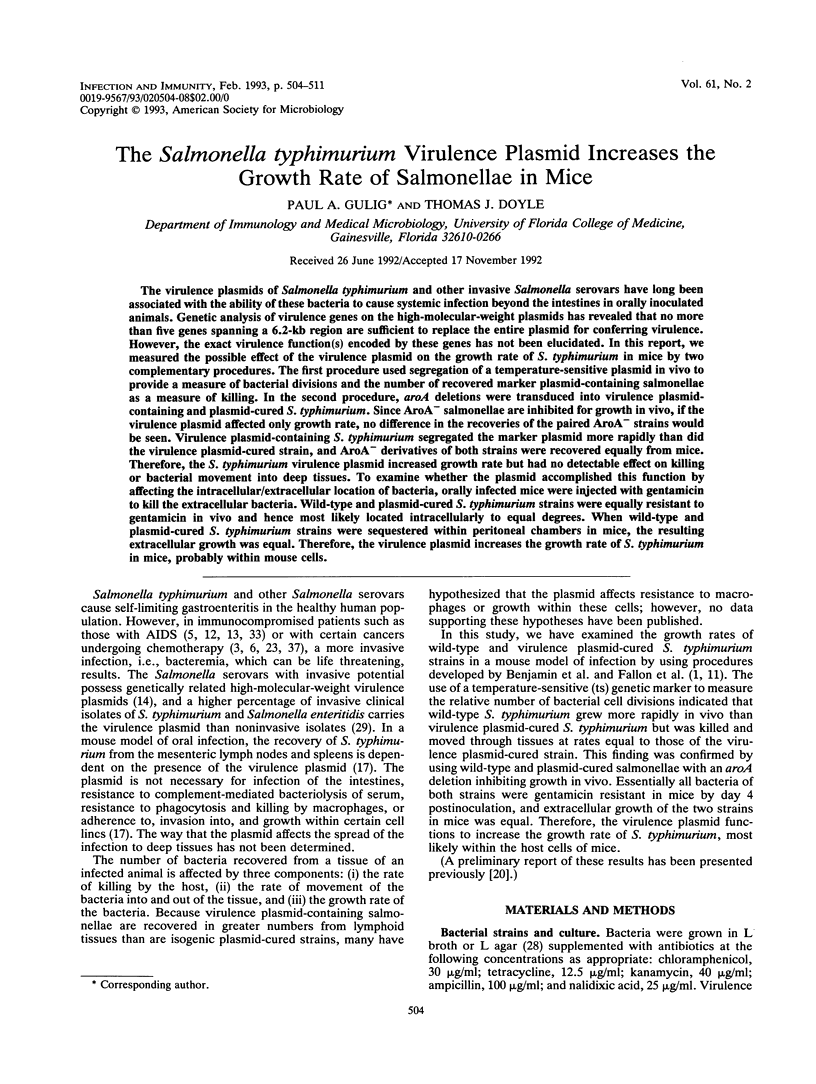
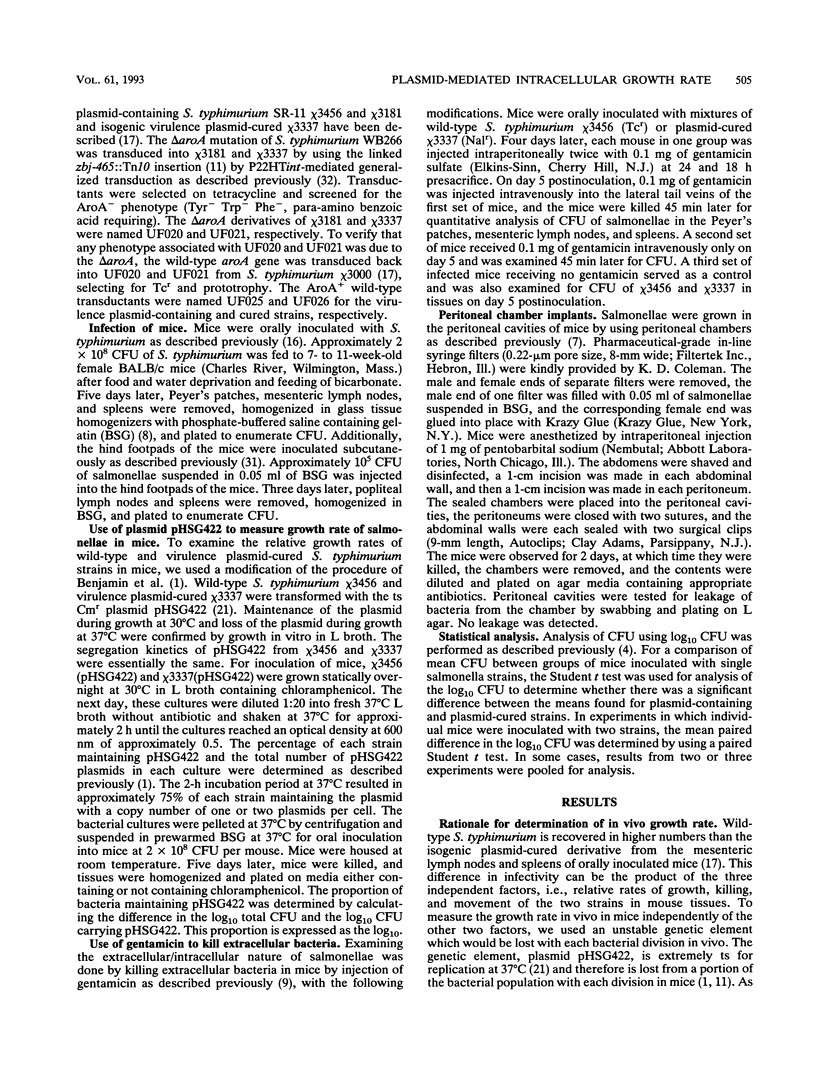
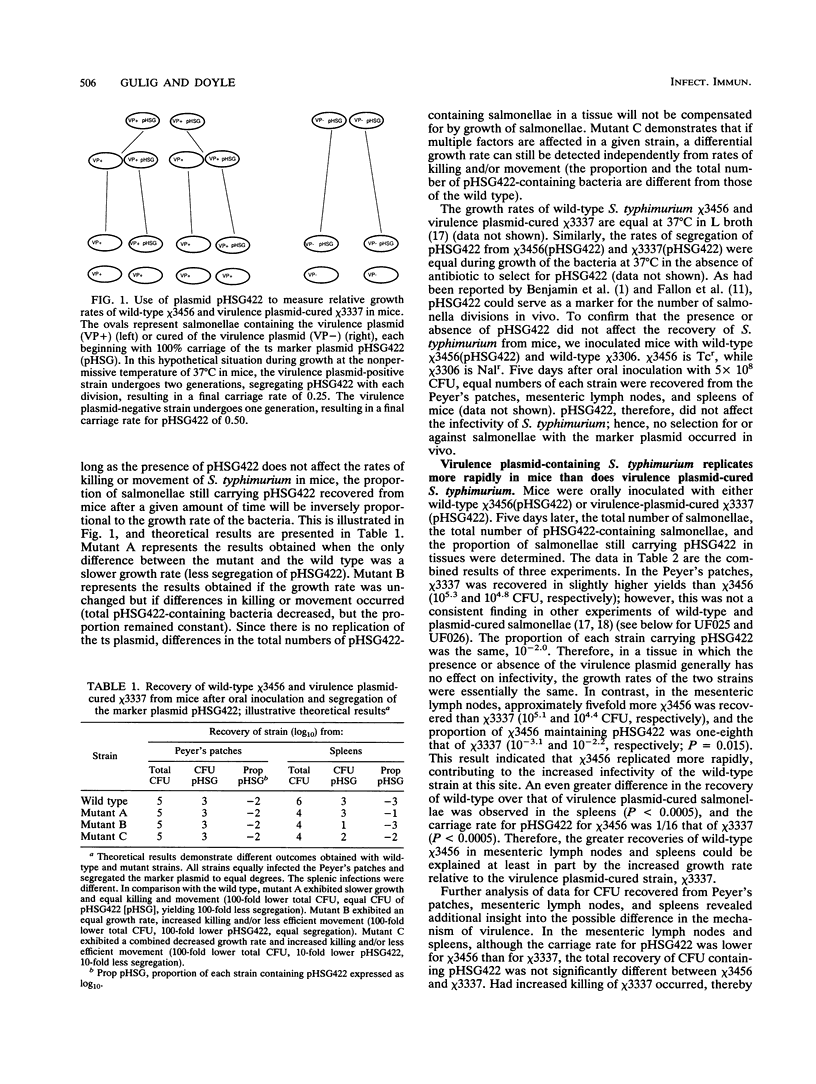
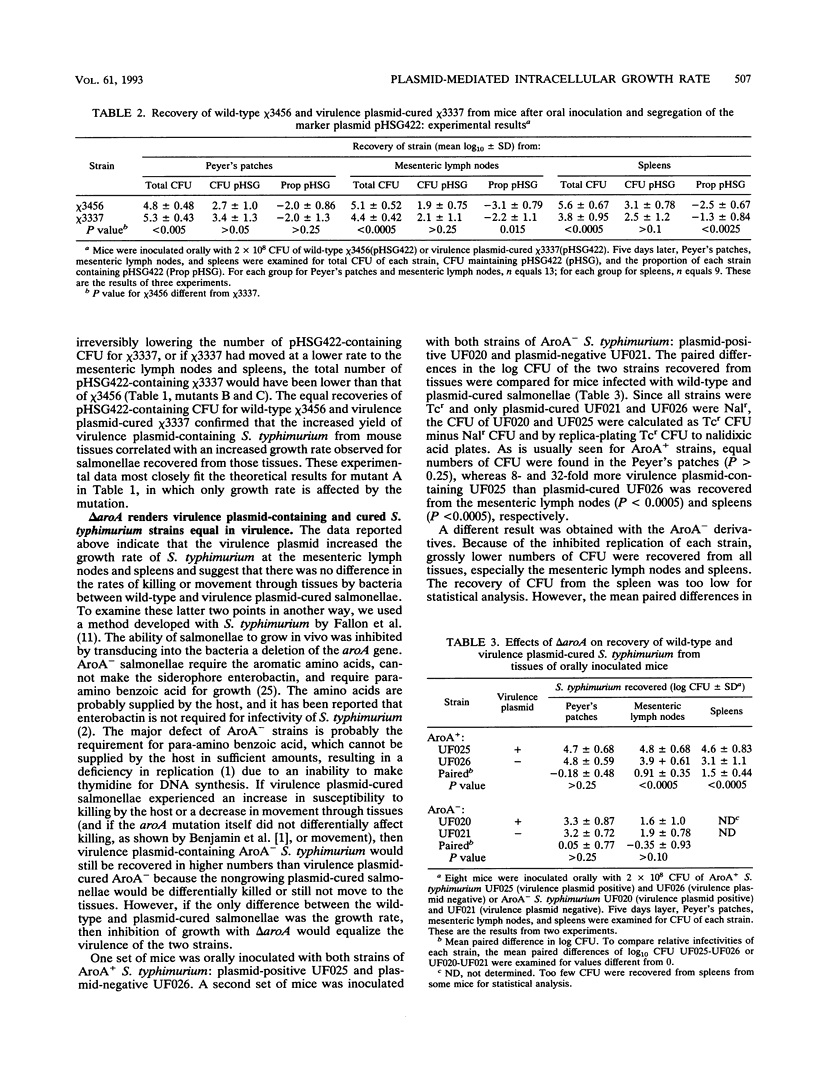
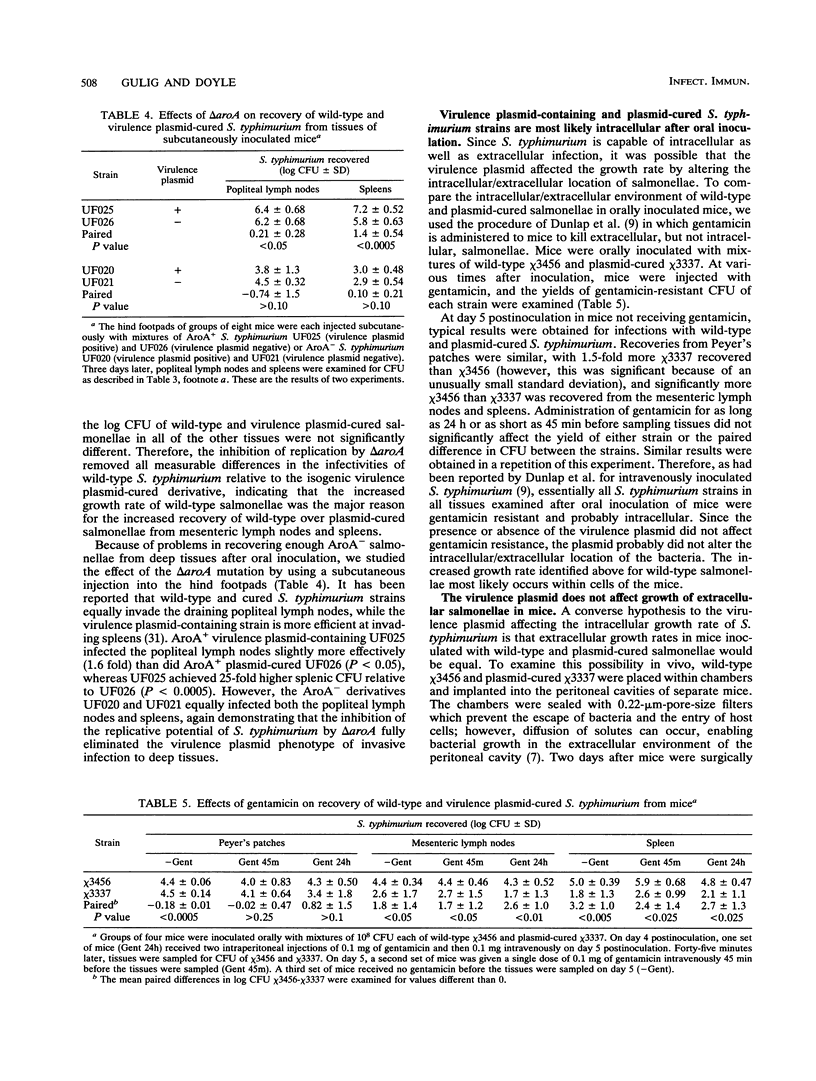
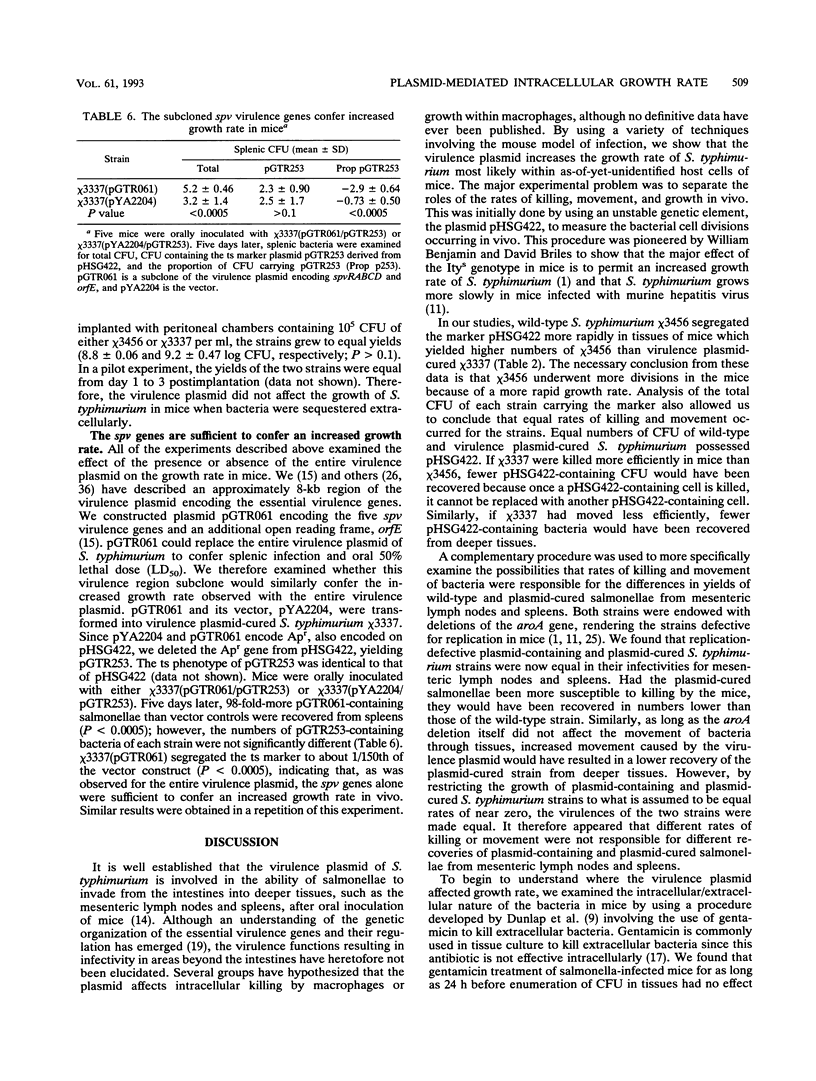
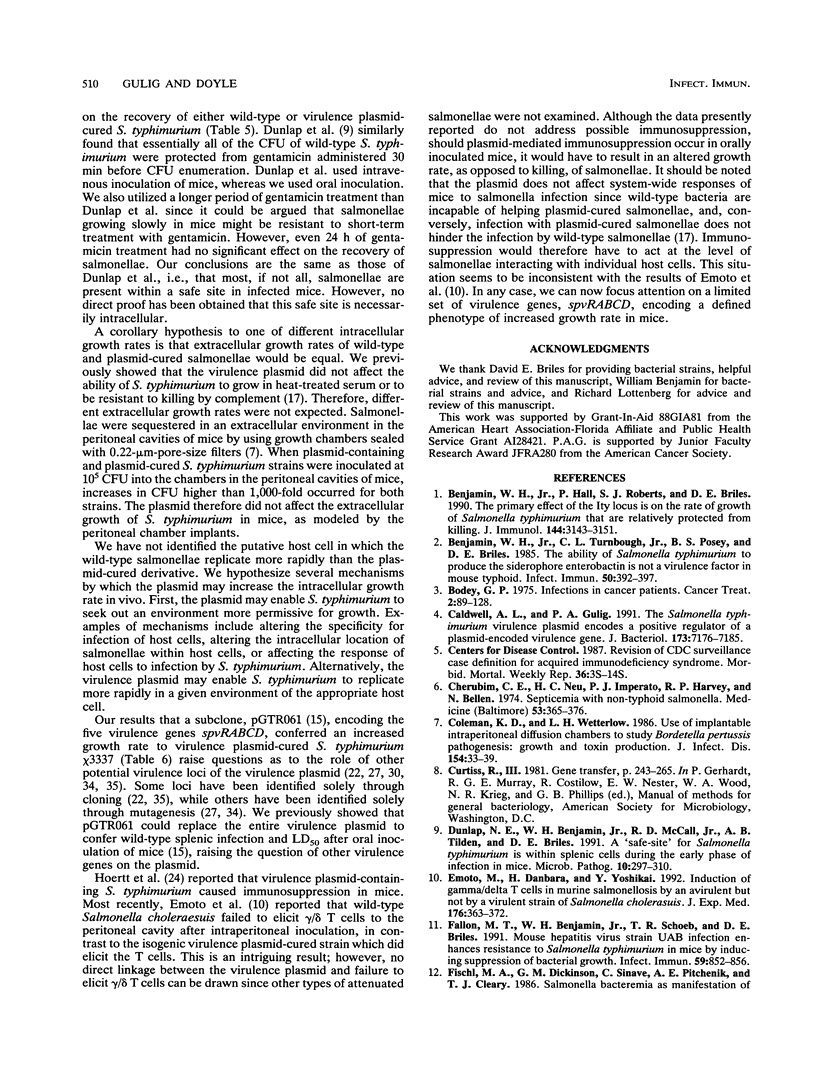
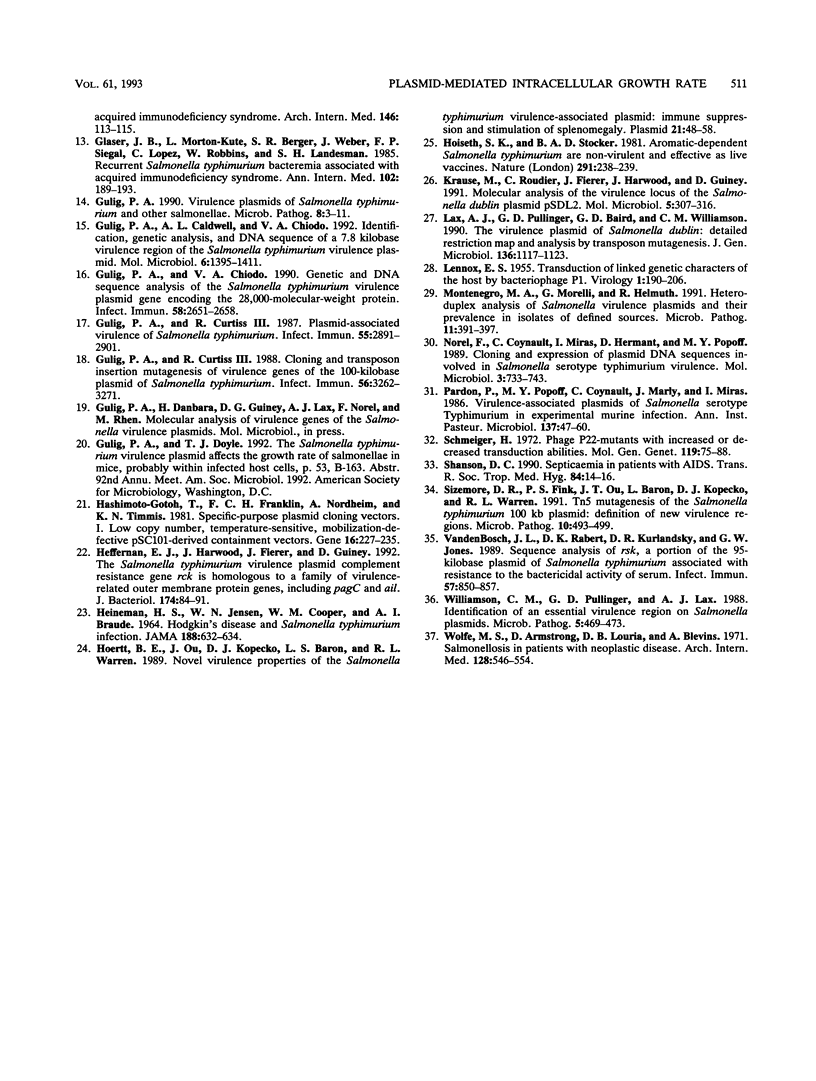
Selected References
These references are in PubMed. This may not be the complete list of references from this article.
- Benjamin W. H., Jr, Hall P., Roberts S. J., Briles D. E. The primary effect of the Ity locus is on the rate of growth of Salmonella typhimurium that are relatively protected from killing. J Immunol. 1990 Apr 15;144(8):3143–3151. [PubMed] [Google Scholar]
- Benjamin W. H., Jr, Turnbough C. L., Jr, Posey B. S., Briles D. E. The ability of Salmonella typhimurium to produce the siderophore enterobactin is not a virulence factor in mouse typhoid. Infect Immun. 1985 Nov;50(2):392–397. doi: 10.1128/iai.50.2.392-397.1985. [DOI] [PMC free article] [PubMed] [Google Scholar]
- Bodey G. P. Infections in cancer patients. Cancer Treat Rev. 1975 Jun;2(2):89–128. doi: 10.1016/s0305-7372(75)80005-3. [DOI] [PubMed] [Google Scholar]
- Caldwell A. L., Gulig P. A. The Salmonella typhimurium virulence plasmid encodes a positive regulator of a plasmid-encoded virulence gene. J Bacteriol. 1991 Nov;173(22):7176–7185. doi: 10.1128/jb.173.22.7176-7185.1991. [DOI] [PMC free article] [PubMed] [Google Scholar]
- Cherubin C. E., Neu H. C., Imperato P. J., Harvey R. P., Bellen N. Septicemia with non-typhoid salmonella. Medicine (Baltimore) 1974 Sep;53(5):365–376. doi: 10.1097/00005792-197409000-00003. [DOI] [PubMed] [Google Scholar]
- Coleman K. D., Wetterlow L. H. Use of implantable intraperitoneal diffusion chambers to study Bordetella pertussis pathogenesis: growth and toxin production in vivo. J Infect Dis. 1986 Jul;154(1):33–39. doi: 10.1093/infdis/154.1.33. [DOI] [PubMed] [Google Scholar]
- Dunlap N. E., Benjamin W. H., Jr, McCall R. D., Jr, Tilden A. B., Briles D. E. A 'safe-site' for Salmonella typhimurium is within splenic cells during the early phase of infection in mice. Microb Pathog. 1991 Apr;10(4):297–310. doi: 10.1016/0882-4010(91)90013-z. [DOI] [PubMed] [Google Scholar]
- Emoto M., Danbara H., Yoshikai Y. Induction of gamma/delta T cells in murine salmonellosis by an avirulent but not by a virulent strain of Salmonella choleraesuis. J Exp Med. 1992 Aug 1;176(2):363–372. doi: 10.1084/jem.176.2.363. [DOI] [PMC free article] [PubMed] [Google Scholar]
- Fallon M. T., Benjamin W. H., Jr, Schoeb T. R., Briles D. E. Mouse hepatitis virus strain UAB infection enhances resistance to Salmonella typhimurium in mice by inducing suppression of bacterial growth. Infect Immun. 1991 Mar;59(3):852–856. doi: 10.1128/iai.59.3.852-856.1991. [DOI] [PMC free article] [PubMed] [Google Scholar]
- Fischl M. A., Dickinson G. M., Sinave C., Pitchenik A. E., Cleary T. J. Salmonella bacteremia as manifestation of acquired immunodeficiency syndrome. Arch Intern Med. 1986 Jan;146(1):113–115. [PubMed] [Google Scholar]
- Glaser J. B., Morton-Kute L., Berger S. R., Weber J., Siegal F. P., Lopez C., Robbins W., Landesman S. H. Recurrent Salmonella typhimurium bacteremia associated with the acquired immunodeficiency syndrome. Ann Intern Med. 1985 Feb;102(2):189–193. doi: 10.7326/0003-4819-102-2-189. [DOI] [PubMed] [Google Scholar]
- Gulig P. A., Caldwell A. L., Chiodo V. A. Identification, genetic analysis and DNA sequence of a 7.8-kb virulence region of the Salmonella typhimurium virulence plasmid. Mol Microbiol. 1992 May;6(10):1395–1411. doi: 10.1111/j.1365-2958.1992.tb00860.x. [DOI] [PubMed] [Google Scholar]
- Gulig P. A., Chiodo V. A. Genetic and DNA sequence analysis of the Salmonella typhimurium virulence plasmid gene encoding the 28,000-molecular-weight protein. Infect Immun. 1990 Aug;58(8):2651–2658. doi: 10.1128/iai.58.8.2651-2658.1990. [DOI] [PMC free article] [PubMed] [Google Scholar]
- Gulig P. A., Curtiss R., 3rd Cloning and transposon insertion mutagenesis of virulence genes of the 100-kilobase plasmid of Salmonella typhimurium. Infect Immun. 1988 Dec;56(12):3262–3271. doi: 10.1128/iai.56.12.3262-3271.1988. [DOI] [PMC free article] [PubMed] [Google Scholar]
- Gulig P. A., Curtiss R., 3rd Plasmid-associated virulence of Salmonella typhimurium. Infect Immun. 1987 Dec;55(12):2891–2901. doi: 10.1128/iai.55.12.2891-2901.1987. [DOI] [PMC free article] [PubMed] [Google Scholar]
- Gulig P. A. Virulence plasmids of Salmonella typhimurium and other salmonellae. Microb Pathog. 1990 Jan;8(1):3–11. doi: 10.1016/0882-4010(90)90003-9. [DOI] [PubMed] [Google Scholar]
- HEINEMAN H. S., JENSEN W. N., COOPER W. M., BRAUDE A. I. HODGKIN'S DISEASE AND SALMONELLA TYPHIMURIUM INFECTION. JAMA. 1964 May 18;188:632–634. [PubMed] [Google Scholar]
- Hashimoto-Gotoh T., Franklin F. C., Nordheim A., Timmis K. N. Specific-purpose plasmid cloning vectors. I. Low copy number, temperature-sensitive, mobilization-defective pSC101-derived containment vectors. Gene. 1981 Dec;16(1-3):227–235. doi: 10.1016/0378-1119(81)90079-2. [DOI] [PubMed] [Google Scholar]
- Heffernan E. J., Harwood J., Fierer J., Guiney D. The Salmonella typhimurium virulence plasmid complement resistance gene rck is homologous to a family of virulence-related outer membrane protein genes, including pagC and ail. J Bacteriol. 1992 Jan;174(1):84–91. doi: 10.1128/jb.174.1.84-91.1992. [DOI] [PMC free article] [PubMed] [Google Scholar]
- Hoertt B. E., Ou J., Kopecko D. J., Baron L. S., Warren R. L. Novel virulence properties of the Salmonella typhimurium virulence-associated plasmid: immune suppression and stimulation of splenomegaly. Plasmid. 1989 Jan;21(1):48–58. doi: 10.1016/0147-619x(89)90086-3. [DOI] [PubMed] [Google Scholar]
- Hoiseth S. K., Stocker B. A. Aromatic-dependent Salmonella typhimurium are non-virulent and effective as live vaccines. Nature. 1981 May 21;291(5812):238–239. doi: 10.1038/291238a0. [DOI] [PubMed] [Google Scholar]
- Krause M., Roudier C., Fierer J., Harwood J., Guiney D. Molecular analysis of the virulence locus of the Salmonella dublin plasmid pSDL2. Mol Microbiol. 1991 Feb;5(2):307–316. doi: 10.1111/j.1365-2958.1991.tb02111.x. [DOI] [PubMed] [Google Scholar]
- LENNOX E. S. Transduction of linked genetic characters of the host by bacteriophage P1. Virology. 1955 Jul;1(2):190–206. doi: 10.1016/0042-6822(55)90016-7. [DOI] [PubMed] [Google Scholar]
- Lax A. J., Pullinger G. D., Baird G. D., Williamson C. M. The virulence plasmid of Salmonella dublin: detailed restriction map and analysis by transposon mutagenesis. J Gen Microbiol. 1990 Jun;136(6):1117–1123. doi: 10.1099/00221287-136-6-1117. [DOI] [PubMed] [Google Scholar]
- Montenegro M. A., Morelli G., Helmuth R. Heteroduplex analysis of Salmonella virulence plasmids and their prevalence in isolates of defined sources. Microb Pathog. 1991 Dec;11(6):391–397. doi: 10.1016/0882-4010(91)90035-9. [DOI] [PubMed] [Google Scholar]
- Norel F., Coynault C., Miras I., Hermant D., Popoff M. Y. Cloning and expression of plasmid DNA sequences involved in Salmonella serotype typhimurium virulence. Mol Microbiol. 1989 Jun;3(6):733–743. doi: 10.1111/j.1365-2958.1989.tb00222.x. [DOI] [PubMed] [Google Scholar]
- Pardon P., Popoff M. Y., Coynault C., Marly J., Miras I. Virulence-associated plasmids of Salmonella serotype Typhimurium in experimental murine infection. Ann Inst Pasteur Microbiol. 1986 Jul-Aug;137B(1):47–60. doi: 10.1016/s0769-2609(86)80093-x. [DOI] [PubMed] [Google Scholar]
- Schmieger H. Phage P22-mutants with increased or decreased transduction abilities. Mol Gen Genet. 1972;119(1):75–88. doi: 10.1007/BF00270447. [DOI] [PubMed] [Google Scholar]
- Shanson D. C. Septicaemia in patients with AIDS. Trans R Soc Trop Med Hyg. 1990;84 (Suppl 1):14–16. doi: 10.1016/0035-9203(90)90449-o. [DOI] [PubMed] [Google Scholar]
- Sizemore D. R., Fink P. S., Ou J. T., Baron L., Kopecko D. J., Warren R. L. Tn5 mutagenesis of the Salmonella typhimurium 100 kb plasmid: definition of new virulence regions. Microb Pathog. 1991 Jun;10(6):493–499. doi: 10.1016/0882-4010(91)90116-r. [DOI] [PubMed] [Google Scholar]
- Vandenbosch J. L., Rabert D. K., Kurlandsky D. R., Jones G. W. Sequence analysis of rsk, a portion of the 95-kilobase plasmid of Salmonella typhimurium associated with resistance to the bactericidal activity of serum. Infect Immun. 1989 Mar;57(3):850–857. doi: 10.1128/iai.57.3.850-857.1989. [DOI] [PMC free article] [PubMed] [Google Scholar]
- Williamson C. M., Pullinger G. D., Lax A. J. Identification of an essential virulence region on Salmonella plasmids. Microb Pathog. 1988 Dec;5(6):469–473. doi: 10.1016/0882-4010(88)90008-3. [DOI] [PubMed] [Google Scholar]
- Wolfe M. S., Louria D. B., Armstrong D., Blevins A. Salmonellosis in patients with neoplastic disease. A review of 100 episodes at Memorial Cancer Center over a 13-year period. Arch Intern Med. 1971 Oct;128(4):546–554. doi: 10.1001/archinte.128.4.546. [DOI] [PubMed] [Google Scholar]


